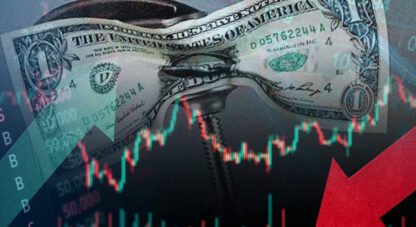Podcast: Play in new window
New Paradigm Dynamics
Disclaimer: Advisory services are offered by McAlvany Wealth Management, an investment adviser registered with the U.S. Securities and Exchange Commission. The comments made in this audio recording discuss economic and market trends and are not intended as advice for any particular investor. A short selling strategy involves a substantial degree of risk. Any decision to engage in a short selling strategy should be reviewed with your financial adviser. Past performance is no guarantee of future results.
MWM Q3 2023 Tactical Short Conference Call
November 2, 2023
David McAlvany: Good afternoon. This is David McAlvany. We’ll go ahead and get started with our Q3 Tactical Short call. We’ve called this “New Cycle Dynamics” because that’s exactly what we’re seeing in the markets—the sensitivity at this point within the fixed income markets and the currency markets, a recognition that something is shifting, changing. And Doug will explore in detail where we see this eventually migrating, not just to further depths within the financial markets in fixed income, but more broadly to the equity markets as well. So, good afternoon. We appreciate your participation in the third quarter 2023 recap conference call. As always, thank you to our valued account holders. We greatly value our client relationships.
With first time listeners on today’s call, we’ll begin with some general information for those unfamiliar with Tactical Short and more detailed information is available at mwealthm.com/tactical short.
The objective of Tactical Short is to provide a professionally managed product that reduces the overall risk in a client’s total investment portfolio, while at the same time providing downside protection in a global market backdrop with extraordinary uncertainty and extreme risk. This strategy is designed for separately managed accounts. With that in mind, these are intentionally investor friendly with full transparency, flexibility, reasonable fees, and no lockups. We have the flexibility to short stocks and ETFs. We also plan, on occasion, to buy liquid listed put options.
Shorting entails a unique set of risks, we’re set apart by our analytical framework as well as our uncompromising focus on identifying and managing risk. Our Tactical Short strategy began the quarter with short exposure targeted at 79%. The target was held steady throughout the quarter, focused on the challenging backdrop for managing short exposure. A short in the S&P 500 ETF SPY remains the default position for high-risk environments.
As we stress during each call, remaining 100% short all the time, as most short products are structured, is risk indifference. Aggressive shorting can be on occasion rewarding, but the market over recent years and in bouts this year inflicted painful losses on the short side for those who are indifferent to risk. We believe that disciplined risk management is absolutely essential for long-term success. We structure Tactical Short to ensure the flexibility to navigate through even the most challenging market conditions.
I’ll cover the update on performance and then Doug will have specific market commentary, and then we’ll move towards question and answer. We’ve received a number of questions already and we’ll prioritize those. If there’s something else that comes up relating to the content in the call, feel free to put that into the chat section below, where we will, assuming time allows, be able to address those questions as well.
So updating performance, Tactical Short accounts after fees returned 3.35% during Q3. The S&P 500 returned a negative 3.27%. So for the quarter, Tactical Short accounts returned 102% of the S&P 500’s negative return. As for one-year performance, Tactical Short after fees returned a negative 12.17 versus the 21.59% positive return of the S&P 500. So Tactical Short lost 56.4% of the S&P’s positive return. And Doug will comment further on this differentiation, where we’re losing less and making more, and a lot of that has to do with rebalancing tactics, which Doug has refined over his many decades of doing this.
We regularly track Tactical Short performance versus three actively managed short competitors. First, the Grizzly Short Fund, which returned a positive 7.62% during the quarter. Over the past year, Grizzly has returned a negative 16.77. Ranger Equity Bear returned a positive 3.63 for the quarter, with a negative 22.6 one-year return. Federated Prudent Bear returned 3.03% during Q3 and a negative one-year return of 17.86%.
Tactical Short performed in line with two actively managed short funds during the quarter, while underperforming the Grizzly Short Fund. On average, Tactical Short underperformed by 141 basis points during the quarter. Tactical Short outperformed all three funds over the past year by an average of 690 basis points. Tactical Short has significantly outperformed each of the bear funds since inception. From the April 7th, 2017 inception through the end of September, Tactical Short returned negative 38%—38.1% versus the 103.89 return for the S&P 500, while on average outperforming the three competitors by 2,694 basis points, or almost 27 percentage points.
There are also the popular passive short index products, the ProShares Short S&P 500 ETF, which returned 5.48 for the quarter and a negative 13.28 for the past year. The Rydex Inverse S&P 500 fund returned 5.65 during Q3, negative 13.11 over the one year. And then there’s the PIMCO StsockPLUS Short Fund, with a Q3 return of 6.23, and a one-year return of 11.52%.
Doug, we’ll go over to you.
Doug Noland: Thanks, David. Good afternoon everyone. Thank you for being on today’s call. It became a habit to describe quarters as extraordinary. It just seems we’ve moved beyond extraordinary. Analysts now refer to the worst bond bear market in decades. Geopolitical experts are warning of the most dangerous backdrop since World War II. And I’m focused on what I believe is the riskiest market environment in my more than three decades in investment management. To begin, I’ll comment on performance.
I’m pleased that Tactical Short accounts return more than the S&P 500’s decline during the quarter. It’s worth noting, unlike our competitors, Tactical Short has yet to experience a quarter where losses exceeded the S&P’s return. A 79% short exposure during the quarter was the highest in the history of the strategy. And it certainly helped performance to earn a nice return on our cash holdings. Since the great financial crisis, near zero policy rates have been a huge disadvantage on the short side. Not only do low rates boost stock prices and promote speculative excess, including the propensity for short squeezes, zero rates also eliminate returns on the cash we hold in Tactical Short accounts as collateral against our short positions. For those unfamiliar with the logistics of shorting, we don’t have to spend cash to establish short positions. Our Tactical Short accounts remain fully invested in cash, generating cash returns. And it’s great to finally see the return of this performance benefit.
I’ll also comment on relative performance. I’m pleased as well that Tactical Short performance was slightly ahead of Prudent Bear and only somewhat lagged the Ranger Bear Fund. Both these funds run higher beta short portfolios than Tactical Short, typically suffering larger losses during market advances. While stocks declined for the quarter, they performed strongly in July. A significant short squeeze saw the Goldman Sachs Short Index gain 17% in July. The Ranger Short Fund lost 10% that month compared to the 3% S&P 500 gain.
Even though short stocks reversed sharply lower in August and September, many short strategies had holes to dig out from. Painful short squeezes are a fact of life in this highly speculative market environment. They inflict quick and outsized losses, and tend to hit short managers when they least expect them. This week is a case in point. In the middle of a geopolitical crisis, the Goldman Sachs Short Index has surged 9% so far this week. It has been fundamental to Tactical Short strategy to position to minimize risks of being caught in squeezes and suffering outsized losses. And it was a quarter where, even with the market’s decline, Tactical Short posted positive returns in line with higher-risk strategies. Our rebalancing strategy also benefited performance during the quarter.
This gets somewhat confusing. Unlike investing on the long side, short exposure and account value—they move in opposite directions. A quick explanation: When market gains cause losses on the short side, short positions increase in size while account value is reduced by losses. And when the market declines, short positions are reduced in size as account value is boosted by positive returns.
Rebalancing refers to the process of adjusting short exposure back to a designated target level. Most short funds rebalance daily back to 100% short, meaning when the market rises and short positions increase in size while account value declines, the fund will buy back some of the short positions to get exposure back down to the 100% target. And when the market declines, the fund will add to short positions to get back up to 100% short. This trading is called rebalancing. Keep in mind that the greater the amount of short exposure and the higher its volatility, the larger the daily gains and losses to account value, that means these trades to rebalance will be bigger in size. This recurring buying and selling can have a meaningfully negative impact on performance, especially in volatile environments.
The Tactical Short strategy is to manage short exposure carefully as to minimize this negative rebalancing impact. We don’t rebalance daily, but instead set a discretionary band around our target to reduce the volume of rebalancing trades and hopefully optimize the impact of these trades. Throughout the quarter, our discretionary band around the short target worked to reduce what can amount to repetitive by high sell low trading. Our rebalancing strategy was helpful for Q3 performance.
Let’s jump to new paradigm dynamics. Our macro view holds that markets—and really the entire world—is in the throes of a transitional phase to a new cycle. The quarter provided important thesis confirmation. 10-year Treasury yields ended the quarter at 4.57%, up 73 basis points, with yields last week trading above 5% for the first time since 2007. MBS yields surged to 6.85%, the high all the way back to 2002. Mortgage borrowing rates hit 8%. Third quarter GDP growth surged to 4.9%. Core inflation accelerated during the quarter, with year over year inflation remaining above 4%. The unemployment rate inched up to 3.8%, though job openings rose to 9.6 million. Despite surging mortgage rates, home price inflation continued.
These data points convey the nature of inflationary economies. Through various channels, the forces of inflation work to sustain demand. Excluding the accounting benefit from the reversal of student loan forgiveness, our federal government ran a $2 trillion deficit for the fiscal year ended in September. Household spending has been supported by strong job and wage growth, higher stock and home prices, residual pandemic savings, and now by the added benefit of much higher returns on cash savings.
It’s worth noting a remarkable statistic. Household sector combined holdings of deposits, Treasurys, and agency securities surged 6.3 trillion, or 42%, just over the past four years to 22.3 trillion.
The quarter featured a major shift in market perceptions. Optimism was running high to begin the period. Expectations had inflation poised to stay on a steady downward trajectory, allowing the Fed to wrap up its tightening cycle. Market chatter was of immaculate disinflation and the coveted soft landing. With a storm having passed, it was definitely time to buy bonds again. The S&P 500 traded above 4,600 in late July. And recall that 10-year Treasury yields dropped to as low as 3.75% mid-month. With MBS yields trading below 5.5% in July, popular Wall Street economist Ed Yardeni referred to a Nirvana scenario.
Unfortunately, the current environment is anything but Nirvana. 10-year yields jumped a hundred basis points, MBS yields, 200 basis points off July lows. Such confusion, indecision and market volatility are part and parcel to a transition to a new cycle. What’s more, the previous multi-decade cycle was so extraordinary for finance, the markets, economic development, and global relations. We have been anticipating an especially challenging transition period. Such a phenomenal supercycle doesn’t change over without fireworks.
The third quarter had elements of a transition period inflection point. The quarter began with expectations of an imminent return to normal, to meager inflation, low market yields, an accommodative Federal Reserve, and perpetual bull markets. The Fed’s dot plot revisions at its late July meeting provided a catalyst for an overdue reality check. “Higher for longer” is a catchphrase for “dynamics have changed.” We see confirmation that new cycle dynamics are now firmly in play. And it’s fitting they emerged most conspicuously in bond trading.
We discern a momentous shift in market perceptions and pricing dynamics. For the first time in decades, Treasury supply has become a key determining factor in market yields. Bond analyst fixation has shifted away from the Fed, with focus now on deficits and Treasury auctions. And despite much more attractive yields across the curve, there is legitimate concern for the sources of demand necessary to absorb unending massive deficit spending. Dominant buyers from the previous cycle, the Fed and foreign central banks, have turned sellers.
Bond market angst is a global phenomenon. The over-indebted European periphery has been under notable pressure. Fiscally challenged Italy bond yields have spiked to 2012 debt crisis levels. Over-indebted EM country bonds have suffered major losses, with fledgling de-risking/de-leveraging, stoking currency weakness, hot money outflows, and contagion. And with the Bank of Japan loath to commence policy normalization, the yen has sunk to lows all the way back to 1990. As rising global yields complicate the BOJ’s yield curve control policy.
I believe bubble analysis is today indispensable for grasping unfolding new cycle dynamics. After witnessing the phenomenal emergence of non-bank finance throughout the ’90s, I began posting the credit bubble bulletin in 1999. I watched carefully as the ’90s bubble gathered momentum through a series of crises in central bank bailouts only to succumb to parabolic excess, with 1999’s almost doubling of NASDAQ. I thought the bubble had burst in 2000, but witnessing double-digit mortgage credit growth, egregious leveraged speculation, and inflating home prices, I reversed course in early 2002, warning of a mortgage finance bubble. I chronicled mortgage and speculative excess on a weekly basis. I again thought the bubble had burst in 2008, but witnessing how far policymakers were willing to go for system reflation, the following year I warned of the emerging global government finance bubble, the granddaddy of all bubbles. After 15 years, a multi-decade credit bubble is again acutely vulnerable.
Importantly, the bubble fueled by perceived safe and liquid government money is fundamentally different from preceding bubbles. Money is something we trust for its attributes of safety and liquidity. In contrast to junk bonds and Lehman Brothers liabilities, there’s no point will we protest, “No more. I’ve got enough government money.” And it’s this insatiable demand that creates the ultimate fuel for protracted bubbles and resulting deep structural maladjustment.
Outstanding Treasury securities ended June at 27.7 trillion. Incredibly, Treasurys ballooned to 21.7 trillion or 360% since the end of 2007. This is precarious end-of-cycle crazy unfolding at the very heart of finance. Trusted credit bestowed with attributes of moneyness. As history informs us, such credit will be issued in increasingly gross excess, with the valuation ensuring an eventual crisis of confidence.
Let’s not disregard 12 trillion of agency securities that expanded an unprecedented 2.8 trillion, or 32%, just over the past four years. Incredibly, in four years, okay? In four years, combined Treasury and agency securities balloon to 12.6 trillion or 47%. This is reckless government finance bubble, terminal phase excess, parabolic issuance of risky non-productive credit that dooms the bubble and cycle. And things have begun to come home to roost.
Markets are finally demanding significantly higher-risk premiums, commencing a problematic phase of bubble restraint. Market adjustment to new paradigm dynamics had begun a year ago, only to be interrupted first by the policy response to the UK bond crisis and then in March with the US banking crisis bailout. Importantly, the Fed and FHLB 700 billion March liquidity injection unleashed a speculative cycle that negated policy tightening. Loose market conditions stoked demand and credit growth while sustaining tight labor markets, all conspiring to ensure inflation-established deep roots.
Importantly, new paradigm dynamics are now entrenched, with markets in the throes of a major adjustment to so-called higher-for-longer. This is a huge problem for an over-indebted global system and highly leveraged markets, for a fragile China, for Bank of Japan policy normalization years overdue. It’s a problem for our banking system with their large held-to-maturity bond portfolios, along with the bloated and thinly capitalized GSEs.
David: Doug, what that suggests is that the March bank problems revealed an acute situation, which to a lesser degree perhaps remains broad-based, and you begin to realize how thinly capitalized both the commercial and central banks are, yet Fed capital, currently at $42.7 billion—which sounds a lot. Sounds like a lot until you compare it to the Fed’s losses.
Doug: Yeah, that’s right, David. Yeah, excellent point. With Washington facing spiraling debt service costs and uncontrollable deficits, Treasury and agency debt markets are at the epicenter of this tumultuous transition to new cycle dynamics. And it’s worth underscoring, and you just touched on this, the Federal Reserve’s estimated $1 trillion loss on its Treasury and agency holdings. While this unprecedented hole in the Fed’s balance sheet—it doesn’t immediately pose a threat to the functioning of monetary policy. But how could it not influence future Federal Reserve bailout and QE decisions?
I believe the inflationary reaction to the March liquidity injection coupled with the enormous losses on Fed holdings will have the Fed reluctant to launch another QE program, especially a massive one. While I see the Federal Reserve in a crisis environment having no option than to resort to additional QE, they will likely move more slowly and with smaller scope than markets have been conditioned to expect.
Market adjustment to new Fed backstop dynamics will be problematic. I believe a new paradigm—their dynamics pose major risk to government finance bubbles across the globe. And if Treasury and agency markets are at the core of faltering bubbles here at home, China is the epicenter of the deflating global bubble phenomenon. New paradigm dynamics took decisive hold in China during the quarter. The old foolproof policy toolkit just doesn’t work like it used to. Despite myriad Beijing pronouncements and stimulus measures, China’s collapsing real estate bubble took a decisive turn for the worse. Country Garden is emblematic.
Not many months ago, China’s largest and most well-known developer was viewed as financially sound, isolated from the travails of Evergrande and others. Having traded at 16% in July, Country Garden bond yields began the quarter at 65% only to surge to over 250%, bonds trading at a few pennies on the dollar. It’s now in default on debt obligations. While behemoth Evergrande faces the specter of a messy liquidation. It’s incredible that these two failed developers account for over a half a trillion dollars of liabilities in a number that is frankly difficult to comprehend.
Bloomberg estimates total Chinese developer debt at 12.4 trillion. With apartment buyer confidence in tatters, new paradigm dynamics have taken firm hold. Beijing’s efforts to revive optimism are stymied, especially as developer debt crisis contagion engulfs other vulnerable sectors. If focus remains on Chinese GDP with growth on track to achieve Beijing’s 5% mandate, I say disregard China GDP statistics. The key storyline at this late bubble phase is that reckless credit growth is required to meet Beijing growth targets, that only unrelenting double-digit credit expansion staves off bubble collapse.
Stress is now mounting throughout China’s $12 trillion local government debt sector, with special concern for local government financing vehicles, or LGFVs. For years, cities and municipalities across China used land sales proceeds to finance lavish infrastructure projects and other development. That developer implosion caused a collapse in this key revenue source, with scores of local governments and financing vehicles now financially impaired.
Beijing has moved to bolster this sector, but like policies to support the developers, stabilization measures that succeeded in the past, these days have muted impact. Let me repeat the scope of the problem. The developers’ 12 trillion and the local governments’ 12 trillion equates to 24 trillion of suspect credit, and this excludes the fragile corporate sector. So far, the credit cycle survives on the back of government debt growth and the ongoing historic ballooning of China’s banking system. Bank assets jumped another 5.3 trillion, or over 10%, the past year to $56 trillion. Bank assets have expanded ten-fold since 2004 and six-fold since the great financial crisis. And now China’s banking system is directed to step up risky lending, to assist the troubled developers and deflating apartment markets. They’re also directed to lend to the local government sector while rolling over and reducing rates on troubled government debt.
The house of cards Chinese banking system is today propped up by faith that Beijing won’t allow a systemic crisis. Prolonging such terminal phase excess is the kiss of death to a sound currency. Considering the ongoing historic expansion of credit of atrocious quality, it’s no surprise that China’s currency is trading near lows back to 2008. Beijing holds control over their companies, banks, local governments, and the Chinese people, but they do not control global currency markets. How long can China’s currency withstand such egregious excess, especially with today’s geopolitics?
Over the past three decades, I’ve observed scores of emerging market bubbles and currencies succumb. I view China no differently. It’s just so much bigger.
Sticking with government finance bubble and new paradigm themes, Japan must be part of the discussion. The yen tanked 1.5% Tuesday to lows back to 1990 as the Bank of Japan drags its heels with long-overdue normalization. The BOJ has for years been locked into an inflationary regime of negative policy rates and yield curve control. To sustain misguided policies, the Bank of Japan is expected to purchase an additional 860 billion of government bonds this year with the BOJ currently holding almost 60% of total Japanese government debt.
Meanwhile, the spike in global yields has significantly compounded already high-risk Japanese policy. The BOJ needs to raise rates and allow yields to rise to mitigate the risk of disorderly currency devaluation, but measures to loosen yield curve control risk a destabilizing spike in bond yields, which would inflict heavy losses on holders of Japanese debt, including the BOJ, while further destabilizing global bond markets.
As was confirmed Tuesday, the usual cautious baby-step approach to policy adjustment no longer works. Markets responded to the BOJ’s yield curve control tinkering with the highest bond yields in 13 years and the weakest currency in 33 years.
China and Japan are in trouble. The risk of disorderly currency devaluation and contagion is high. A collapsing Chinese bubble comes with momentous ramifications. Beijing’s response to acute instability will surely foment geopolitical instability.
The odds of Beijing using Taiwan to divert attention from its domestic failures rise as China’s bubble deflates. With Xi Jinping hell-bent on pursuing global superpower ambitions, China’s fixation on credit-induced growth is running head-on into a world increasingly suspicious of all things China. Destabilizing capital flight and onerous capital controls seem inevitable. Analysis I’ve shared previously seems only more germane. Bubbles are mechanisms of wealth destruction and redistribution with negative consequences for social and geopolitical stability.
Boom periods engender perceptions of an expanding global pie. Cooperation, integration, and alliances are viewed as mutually beneficial, but late in the cycle, perceptions shift. Many see the pie stagnant or shrinking. Zero-sum game thinking dominates. Insecurity, animosity, disintegration, fraught alliances, and conflict take hold.
New paradigm dynamics are very much in play within the geopolitical realm. The US has become deeply involved in a second war. Risks are high that the Israeli-Hamas war escalates into a regional conflict. At the minimum, the world has become even more fragmented than it was on October 6th. It’s worth noting the prominence given to Putin and Xi Jinping’s recent Belt and Road Summit. Russian foreign minister Lavrov was also in Beijing for high-level meetings, and upon departure flew directly to North Korea to see Kim Jong-Un. Moscow and Beijing have been in close consultation with Iran. They’re moving quickly in the Middle East and elsewhere to cement their anti-US alliance.
The world is an increasingly hostile, risky place. Both Putin and Xi see advantages in having the US bogged down in an expanding Middle East conflict. Spreading US focus and military assets is a benefit both for Russia’s war with Ukraine and China’s quest for dominance in the South China Sea and Taiwan Strait. Markets have begun to factor in heightened geopolitical risk—another important facet of the new cycle paradigm.
Markets previously were content to disregard geopolitical developments, confident that central banks were willing and able to counter any negative impact that might materialize. Besides, with such interrelated markets and economies, surely no major global player would view it in their interest to allow conflicts to escalate. But as bubbles falter globally, the old paradigm is losing relevance. China and Russia are moving swiftly to build their anti-US alliance, developing financial and economic structures immune to Western sanctions and pressures.
Old relationships and interdependencies that kept a lid on geopolitical conflict are breaking down. For the first time in decades, markets faced the prospect of a prolonged period of highly elevated geopolitical risk. We believe a fragmented and adversarial world is a higher-inflation world. We face deficit spending to support allies at war. Expect also a significant boost in US military spending as the reality of a hostile global anti-US alliance forces a reworking of military preparedness in Europe, Asia, and the Middle East, and we expect deficit spending and credit growth generally to be an important facet in arms race and global economic power dynamics.
We anticipate ongoing economic fragmentation will spur deepening trade frictions and sanctions, including more onerous import/export bans. There will be more friend sourcing and less reliance on Chinese manufacturing. Tit-for-tat measures ensure structural supply chain vulnerabilities. Global food and energy insecurity will turn only more acute. We expect sticky inflation along with heightened risk of inflationary shocks, and this points to greater social, political, and geopolitical instability.
Let’s return to global government finance bubble dynamics. As mentioned, there is no new bubble waiting in the wings to supplant government finance. And from years of maladjustment, the US bubble economy structure requires extraordinary ongoing credit growth. All scenarios point to government debt being issued in enormous quantities at least until the marketplace has had enough and begins to impose its will. A strong case can be made that this process has begun.
Last week, 10-year yields breached the 5% level, and this week provided another example of new paradigm dynamics. A Bloomberg headline, “The Big Bond Market Event Wednesday is at the Treasury, Not the Fed.” Just think of this. In the face of a geopolitical crisis and Fed meeting, it was the Treasury’s quarterly refunding announcement that was top of mind for the bond market. Is the Treasury going to boost auction sizes? And at what maturities? It’s been a long time.
To wrap up this new paradigm discussion, let’s shift to a holdover from the previous cycle. There remains unflinching faith in the so-called Fed put. Markets operate with confidence the Fed is ready and able to respond with open-ended liquidity support. This is rational. After all, the Fed in 2020 embarked on an unprecedented five trillion QE program, and March of that year repeatedly boosting the size of its liquidity programs specifically to reverse de-leveraging. And earlier this year, there was the 700 billion liquidity response to bank runs.
I’ll focus for a minute or two on comments made last week at the Robin Hood Investor Conference. Ken Griffin, the head of powerful hedge fund and trading firm Citadel, was blasting the SEC for the agency’s concern for the popular hedge fund leveraged basis trade. These basis trades, where hedge funds place leveraged bets in Treasury futures to play the spread between cash and futures, can be 50- to 100-times levered. Citadel’s and others’ highly leveraged basis trade portfolios were blowing up in March 2020—that is, until they were rescued by Fed QE.
Legendary hedge fund operator Paul Tudor Jones candidly admitted as much at last week’s conference, stating, “The Fed’s entrance in the market bailed out that particular book.” Not surprisingly, the basis trade and leveraged speculation recovered to only grow bigger than ever. Last Friday CBB focused on this subject, so I won’t delve too deeply into the numbers. But I will highlight that the repo market, a key financing source for leveraged speculation, ended June at 7.7 trillion—about 40% larger than March 2020’s then record. One-year growth total, 1.3 trillion, or 20%. Broker dealer repo liabilities posted one-year growth of 521 billion, or 34%, to a record 2.1 trillion.
I’m worried that unprecedented leveraged speculation is a proverbial ticking time bomb. When he wasn’t criticizing regulators, Ken Griffin made pertinent comments on market liquidity dynamics. He said, “the largest risk Citadel faces is when pricing correlations between assets go off the rails. When you see repeated divestitures by market participants in the same direction day in and day out, that really puts a lot of pain into our portfolio.” Well, Citadel and other highly leveraged players operate as too big-to-fail institutions. Their leverage and market positioning leave them acutely vulnerable to any serious bout of market de-leveraging and resulting illiquidity. They run their incredibly lucrative operations, confident the Fed and global central bank community will intervene to reverse market risk-off trading before speculative de-leveraging attains crisis momentum, before illiquidity dislocation in markets going off the rails.
I’m quite worried by how this is playing out. Financial and economic systems should by now be well into major adjustments to much higher rates and market yields, worsening global fragilities, and a rapidly deteriorating geopolitical backdrop. Whether it’s inflation, bond yields, deficits, political dysfunction, Chinese bubbles, our soured relationship with China, the new world order, conflicts in Ukraine and the Middle East, and the looming Taiwan issue, there is today extraordinary uncertainty that should have players reining in leverage. Yet market leverage is greater than ever. The system is today poised precariously at peak speculative bubble.
Faith in central banking is dangerously misguided. Granted, the Fed and others have repeatedly rescued markets and reenergized bubbles, but each bailout fostered greater speculative excess and the need for the next even-larger bailout. With pandemic QE scaling 5 trillion, how much will be required for the next bailout?
Circling back to new paradigm dynamics, I believe the bond market is returning to its roots as a powerful imposer of discipline. There will be of course, ebbs and flows and short squeezes. Washington doesn’t realize it yet, but they will finally be forced to rein in profligate spending. Moreover, I suspect going forward the bond market will not look as kindly at big Fed liquidity injections.
New cycle dynamics are much different. With inflationary forces now deeply embedded throughout the real economy, inflationary stimulus will no longer remain conveniently contained within the financial sphere. Instead, big QE will mean higher inflation and higher bond yields. And this dynamic raises serious questions for a lot of assumptions premised on the availability of unlimited central bank liquidity for market bailouts.
Markets today are much too complacent regarding unfolding global de-risking/de-leveraging. There is under-appreciation for the massive scope of speculative leverage while the efficacy of prospective central bank liquidity backstops is overrated. And thinking in terms of Jim Griffin’s off-the-rails market instability, necessary ingredients for global crisis are in plain sight. China’s banking system and currency are accidents in the making. Bank of Japan policy normalization risks disorderly currency and bond markets.
Disorderly renminbi and yen have clear potential to unleash acute global currency instability, with levered EM carry trades vulnerable to de-leveraging and problematic contagion. Despite all the bullish talk of American exceptionalism, our highly leveraged system is today exceptionally vulnerable to de-risking/de-leveraging emanating from synchronized global markets. And contemplating the proliferation of derivatives trading—particularly the reliance on option hedging strategies, along with the popularity of zero-days-to-expiration option speculation. How does this not end with a financial accident?
The US economy is today overheated, the product of the interplay between loose financial conditions, highly speculative financial markets, and powerful inflationary impulses. Don’t extrapolate current growth dynamics. I expect unfolding de-risking/de-leveraging to tighten US financial conditions with clear potential for disorderly tightening. This is not a system that will function well under tight conditions. There’s too much leverage in a multitude of uneconomic enterprises. A system severely maladjusted from the previous cycle’s decades of loose conditions. We should expect this transition to new cycle dynamics having taken hold in the bond market during Q3 to broadly expand, impacts to include overdue adjustments in stock market valuation and economic structure. I hope I’m wrong on this, but the transition between major cycles will most certainly be tumultuous and unnerving. David, back to you.
David: Thanks Doug. Your work’s invaluable. And I just want to draw the listener’s attention to something that you do every day, and if it’s not a part of your daily habits, I would encourage you to look at this. If you go to the “Credit Bubble Daily”—of course the weekly report is still out, which is a labor of love, has been done for decades, and is still available for you to read first thing Saturday morning. But the curated news, Doug, that you provide for everyone is absolutely a must. And if you go to the mcalvany.com website, go to the “Market News” section and look under Credit Bubble Bulletin, you can either look at the weekly or the daily. Today, as an example, 18 articles that you’ve pulled from the New York Times, pulled from the Financial Times, pulled from Bloomberg, Reuters. It’s such an invaluable— If you want to know what is happening in the markets and on a broad basis, understand the interplay between international relations, domestic policies, fiscal monetary choices that are being made, or the news specific to markets, it is all there.
So I would encourage you to make that a daily habit. Again, the curated news there is second to none. Doug, it’s just a small expression of the kind of diligence you put into everything that you do, and I would encourage folks to take advantage of that.
I also want to just suggest that next steps in terms of Tactical Short would be to get your hands on our disclosure documents and management agreement so you can see what we do, how we do it, and prepared to proceed with account opening. Consider a call with Doug or myself to explore suitability. This kind of a hedging strategy for what you’re doing in your other financial resources is really important.
Okay, so let’s go ahead and go to Q&A. And I’ve got the first one and then I’ll pass the hard ones onto you, as is the norm.
Bob asks, “What is the safe way to preserve assets when I already own gold and silver?” Let me go through a couple of options. T-bills: You do it yourself; you can do it yourself, enroll them at TreasuryDirect. We also offer that service in exchange for a few basis points, and of course we’re focused on short T-bills only. Other than that, we like real things. We like real things with cash flow. We have our MAPS strategy. It’s an alternative to precious metals, but frankly, our mandate stretches beyond perhaps what you’re looking for, Bob—strict asset preservation. The mandate is growth. Risk management is implicit, but look at what you have in physical metals. Consider topping it off. I think there’s good reason to believe 2000, 2100 has been a cap on the price, but not for long.
The call today of course is to help you manage total portfolio risk. So if you have equity exposure with other managers and want volatility reduced, Tactical Short is an excellent way to preserve assets by employing, by deploying this balanced strategy to bring risk mitigation and volatility mitigation to your total portfolio. So that’s a couple of things for you to consider, Bob.
Alan asks, “I was wondering if you could comment on the current number of ETFs versus actively managed mutual funds versus stocks? That sets up my second question. To the extent that ETFs are a large part of the market as price discovery still going on? Can any stock with great fundamentals hold up in a down market, especially if that stock is included in several ETFs? ”
Doug: Okay, David, I’ll give a stab at this. Yeah, I did a quick Google search here and came up with this. There are 8,754 ETFs globally in 2022, compared to 276 back in 2003. Pretty decent growth there. As of 2022, ETFs worldwide managed up to almost 10 trillion US dollars in assets. There were 1,245 ETFs traded on the US markets. Those are actively managed ETFs, 1245, total assets under management of 444 billion. So from those numbers you can see that most of it is passive, just playing indexes or themes or whatever. In 2022, there were 7,393 mutual funds in the United States, and as for stocks, in March of 2023, the NYSC, the New York Stock Exchange, 2,385 stocks, NASDAQ, 3,611. So to the first part of the question, my comment is a simple, it’s an incredibly large number of funds. I guess the upshot of a multi-decade bull market, many more funds than stocks. That doesn’t make a lot of sense to me.
The second part of the question, which is a really, really good question— These days I struggle with a concept of price discovery. In most cases, I don’t see fundamentals playing their traditional role in stock valuation. I suspect it’s rather rare actually. And the way this is supposed to work, stock prices are to be a focus on future prospects, to discount future cash flows, to calculate company value. Current market structure, it’s drifted so far away from those traditional ways of valuing companies, those valuation metrics, an old school analyst wouldn’t recognize the way things are done today. I keep referring to a highly speculative marketplace. Markets are, today, they’re dominated by trend following and performance chasing behavior—much more so than analysis. What are AI stocks worth today? Well, it doesn’t matter. The prices are going up, others own them. So the pressure to add them to portfolios is intense. Just buy them irrespective of price.
More specific to your question. When the market’s advancing, this wall of liquidity flowing into ETFs and mutual funds, it raises all boats, irrespective of company fundamentals. And you imply as much. The same will apply in bear market trading. When money is brushing out of the fund complex, selling will impact virtually all stocks. And I can envisage a scenario where you see a liquidity challenged marketplace where managers, they have to resort to selling the big most liquid stocks to fund withdrawals. And this will put only more pressure on some of the big names with relatively sound fundamentals. And the way a speculative marketplace works, if the speculators smell blood and see pressure on the big liquid names, that ensures more shorting and bearish derivative bets that only place more downward pressure on these market leaders.
That’s the ominous setup for when the bear market hits hard. And I’ve been specifically concerned about the ETF complex for years. I have this issue with this perception of safety and liquidity of ETF shares that they enjoy in the marketplace. I call it the moneyness of risk assets. This creates a latent vulnerability to destabilizing shifts in perceptions. It’s the “holy crap, I thought my shares were safe and liquid, and they’re not. ” The risk for a highly problematic run on ETF shares in particular is high. And since the risk is high, markets assume the Fed will be there as a liquidity backstop. So the Fed will be stretched very thin come the next crisis. And thank you for the question.
David: Brian asks, “When will we know to sell out of some of our gold and silver positions?” Simply put, Brian, I’d say keep listening to the Weekly Commentary. Keep reading the Credit Bubble Bulletin. Tune in every week to Hard Asset Insights. We conceived of an asset management team capable of managing resources under all—even the most stressful—environments back in 2004, and we launched that idea in 2008. A great year to get started. Maintaining a physical metals position through a period of stress and strain is, I think, very important.
Is there a point on the horizon where taking gains and reallocating to undervalued opportunities elsewhere makes sense? I think the answer is yes. We’ve got our communication lines out there. Again, the Weekly Commentary, Credit Bubble Bulletin, Hard Asset Insights, and have built a good team to be able to accommodate such a move. And so I’d just say you’ve come to the right place. Stay tuned, keep in touch.
The next one deals with manufacturing and the economy. “Should jobs and manufacturing return to the US, what will the economy look like? “You want to comment on that? And I’ll say something too.
Doug: Sure, David, I’ll just make brief comments. I think this has already started, and I think it’ll be a major issue going forward. I think we’re going to manufacture a lot more things here in the US, especially critical things, and I think this dynamic is an important factor that will underpin labor tightness and, through labor tightness, inflationary pressures. Again, I think it’s started and I expect this trend to gather significant momentum over the coming months and probably years.
David: Yeah, I agree. I like it, but I think we’re going to feel it. And this is kind of in the category of be careful what you wish for. On-shoring is good for the economy in regards to employment and the building out of our middle class with healthy wages. The downside is wage pressure, which ultimately buttresses pricing pressure as it gets passed along to the consumer. So, like you said, Doug, it’s a mixed bag. If it’s friend-shoring, we’ve already seen a lot of that. Huge growth, if you’re looking at the Mexican economy and the decline in imports from China, but with a massive increase in imports from Mexico, so sort of near-shoring friend-shoring, on-shoring. We’ll have a combination of US manufacturing getting bumped and the near-shoring for that to continue. And just it comes with both the benefit and the cost to go and shop. You will feel it, particularly with manufactured goods, you’ll feel it reflected in the price.
So that impacts the mood, because if the middle class doesn’t have their money going quite as far, you could have sort of the reverse wealth effect where they tend to want to save a little bit more if they can. So again, on the one hand I like it, but we’re going to feel it.
Another question. Looks like this is from the same person. I’ll take a stab at both of these. “Are we somewhat safe in five star banks with CDs under $250,000? ” I think, first of all, it does make sense to diversify large cash positions across multiple institutions. What we have seen particularly, particularly in Q3 is a rapid deterioration in ratings amongst banks that had previously been rated A or even B, or if you’re looking at the star system, sort of five star, four star. So I would just call for updates twice a year, January and July. We provide those ratings at no cost, and we spend a good bit of money subscribing to Weiss Research, which does a comprehensive look at those banks. So I would call for updates January and July, things change quickly. And these portfolio losses that have not been marked to market, should they shift to the realized loss category as deposits migrate to higher yielding Treasurys or the “greener pastures,” you’ll want to know if you’re A-rated bank is still an A-rated bank. And I would not take that for granted in this environment.
You used to be able to look at these various areas within the rating system and not really be concerned about a bank that had a large securities portfolio. You’d say, well, they’re not taking that much risk. They’re in T-bills and mortgage backed securities and you don’t see a ton of volatility in that space. But new cycle dynamics, with inflation being present and rates being pressed higher, now all of a sudden what was a safe bank is not necessarily of the same quality, on the same footing. So by all means check in with us twice a year. We’re happy to do that. Love the conversation. And of course the diversification across multiple institutions makes sense.
The next question from the same person, “Are we somewhat safe in high rated fixed short-term insurance annuities? ”
To be honest, I’m not a fan of annuities. I think better options exist. Insurance companies have really the same portfolio pressures in their securities portfolios, although they don’t have the forced crisis dynamics, which we saw in March with Silicon Valley Bank and other commercial banks. But I think insurance companies get to hide a lot behind a veil of complexity. And I’m only really interested in fixed annuities at the end of an interest rate cycle, at the end of a bond bear market. And I think we’re 10 years away from that, maybe more.
So I wouldn’t leave you on an encouraging note with insurance annuities. I think they’ve got a lot of math still to figure out in terms of how they pay, what they pay, and how they measure the security of their portfolios.
Doug, this one will go to you. “Rarely mentioned in talk of bonds in the current inflationary environment are TIPS, Treasury inflation protected securities. You’d think they’d be getting more loved in an era of high inflation and interest rates. Why hasn’t that been the case, and how has the mechanism of how an investor might presume they would help currently broken down somehow?”
Doug: Sure. I am certainly not a TIPS expert. I’ve never purchased or managed a TIPS position, and perhaps David, you might be able to offer more valuable insight. But let me throw these thoughts out here. I’ve always looked at TIPS with a fair dose of skepticism because they rely on the CPI index to measure inflation, and I’m not so confident that CPI will always accurately capture underlying the actual pricing pressures and inflationary impacts. And we’ve seen this year, regular Treasurys, they’re now factoring in inflation premiums. So in a way, owning TIPS is a bet on CPI versus the risk premium embedded in long-term Treasury bonds.
So the analysis is more complex than most would realize. I know some analysts also have issues with the nuance of TIPS structure, especially how they function in crisis environments where CPI readings can be highly variable. In general, it’s my understanding that the TIPS market is susceptible to greater uncertainty and volatility than the traditional Treasury marketplace. But again, I’m just not very well versed on these issues.
David: Well, I agree with you, Doug, that CPI is a problematic reference. We’ve been able to pretty that up and make it say what we want it to say over time. If you use the models for measuring CPI that were used in the 1970s, where the consumer faced real inflation and monetary policy was aggressive to address that real inflation, if you look at those models and apply them today, we’re almost in the same place. Double digits we have today using the old metrics for CPI. So it’s rather convenient that we get to look at low numbers today, although the consumer is still facing— and I think the anxiety amongst the consumer reflects that.
So that it’s understated I think is a problem. Most Wall Street players steer clear of TIPS and trade in the swaps market instead, of course it gives them a little bit more leverage on that basis. An alternative perhaps would be this, I mentioned TreasuryDirect earlier and this would be a product that you have an access to at TreasuryDirect. Floating Rate Notes from the Treasury. If I was looking for the TIPS market to solve some problem, I think I’d steer towards the FRNs instead.
Floating Rate Notes in my view are a better alternative. They’re indexed to the 13-week Treasury bill. Demand at auction is typically three to five times what the Treasury is offering. If you’re interested, it doesn’t mean you’re necessarily first in line to get them. They’re always 2-year notes. So again, if you are familiar with TreasuryDirect, I think I’d take the floating rate note over the TIPS.
I guess what that really expresses is a higher degree of confidence that, even at the short end of the curve, the market has an ability to influence pricing and yield. And I don’t want to be stuck with statisticians’ view of what inflation is or is not. I think the market ultimately has a clearer view on it and will price things accordingly. So even short end of the curve, 13 week as the index reference, that’s where I would be to capture something that floats.
Next question is from Mike. “Do you feel there’s a scenario with a reasonable probability where there’s a large debt deflation and gold does no better than other assets? It also goes down priced in US dollars from its current levels?” There is a possibility that gold goes down in the context of deflation. I think that the clear-eyed view I borrow from is Roy Jastram’s book The Golden Constant. In The Golden Constant, he charts how gold performs in the context of deflations.
During the depression, purchasing power pickup was about 250%. So even with a decrease in the price of gold, you had, relative to other assets or other items that you need to purchase, still in advance of 250%. In less severe deflations, the minimum increase in purchasing power is closer to 50%. But that’s kind of your worst-case scenario, at least in terms of US market history and deflations.
I know history doesn’t repeat, but the record thus far is that real money is actually more effective—and this is sometimes hard for people to grasp—but more effective in a deflation than in an inflation. And again, I see that and you’ll see that if you want to pick up a copy of The Golden Constant by Jastram. That’s an interesting way of looking at it because obviously many people assume the conventional wisdom is: Gold, inflation—that’s the ticket. Deflation, you might be in trouble. The math is a little different when you’re measuring in relative terms, so certainly you can see it go down in price. The question is relative to everything else. Are you still in a much better position? That’s been the historical record thus far.
Jim Grant in a recent interview said this, and I tend to agree. “I think gold ought not to trade as an inflation hedge, but as an investment in monetary disorder, of which we surely have enough in the world.
“It might be, ” he says, “that paper money in the historian’s retrospective views will seem to have been a failure, and that the world is going to charge back on unconstrained central bank credit creation and unconstrained sovereign borrowing. “
Doug, another couple questions for you. So far the Fed has shrunk its balance sheet by about a trillion dollars. How do you see Treasury supplies impacting rates, and thus tighter financial conditions, over the next 12 months?
Doug: Sure. Another excellent question, and I touched on this in my earlier comments. But the growing supply demand imbalance has already had a significant impact on yields and market dynamics generally. This week a squeeze dynamic has erupted, which always creates the illusion of strong demand and liquidity. But there’s clear potential for the ongoing supply of Treasurys, and really bonds more generally, to fuel liquidity concerns and a further spike in yields.
And it gets little attention, but there are massive derivative hedging markets that kick in when yields move sharply higher, creating these self-reinforcing dynamics. Selling begets selling, especially in the huge market for hedging mortgage-backed securities. There’s always potential for a yield spike, illiquidity, and market dislocation. And I specifically focused on the hedge fund basis trade earlier because of the potential for a very destabilizing unwind of leveraged holdings of Treasury and agency securities.
A major de-leveraging, that would really bring to light the Treasury supply demand imbalance issue. The combination of enormous deficits and speculative leverage creates extraordinary vulnerability, and I see all the necessary ingredients for Treasury market upheaval, which would create much tighter conditions. No doubt about that. And I certainly think that will be an ongoing risk over the next 12 months.
David: Doug, when you mentioned mortgage-backed securities illiquidity, it reminded me of a conversation I had with a client this last week, who just onboarding onto our platform. But was talking about a bond position that he had, and this was not years and years ago, but a corporate bond position which he was looking to liquidate, and there was no price. It wasn’t that it was a lowball price, but it took several weeks to get liquid on what you would assume to be readily cash worthy.
So we do live with this perception, and I go back to the question on ETFs earlier and just what you mentioned about mortgage backed securities. We’re so used to an environment where liquidity is unquestionable. It’s hard for us to imagine not being able to do what we want when we want and to the degree that we want. Another question for you, “What are the implications of higher rates in the JGB market, thinking about US Treasurys primarily, but beyond that as well?”
Doug: Great questions for this call here. Not easy ones. These are tough, but really good questions. I believe the eventual end of yield curve control in Japan, the end of this forced ceiling on Japanese government bond yields, that comes with major ramifications in Japan and globally. The most obvious is that Japanese savers and institutions will have incentive to buy more Japanese bonds, which means sales of Treasurys and other bonds, or at the minimum sharply reduced buying.
There’s been a wall of liquidity coming out of Japanese institutions buying global bonds, but it also means the Bank of Japan will be significantly less accommodated. They’ll be adding less liquidity into the system—and that’s a global system—to their yield curve control operations. I mentioned earlier, the BOJ is forecast to purchase $860 billion of bonds this year, where much of this liquidity flows globally and provided really important support to global markets.
And it’s led to looser financial conditions more generally. And we can assume that the phase out of yield curve control will be part of BOJ so-called policy normalization. They need to raise rates and tighten policy to mitigate the risk of a disorderly currency devaluation. They are so incredibly far behind the curve here. And with ultra cheap Japanese finance being a key funding source for global leverage speculation, this normalization process comes with huge risks to global liquidity and market stability. Who knows the size of the carry trade of finance in Japan. Could it be a trillion, more than a trillion, of just easily borrowed money? And I’m sure that this is the Japanese ongoing stimulus here. And the related fragility is a reason why BOJ officials have remained so timid in starting normalization, but they’ve got to get going. The markets have signaled that again this week.
David: Well, just to summarize, what I heard you say is normalization equals risk to global liquidity, and that really has to do with the carry trade unwinds—the X factor we can’t wrap our minds around or get our arms around in terms of the scale. So what happens in Japan and in China, as you noted in your comments earlier, very significant for global financial markets.
Here domestically, last question. “If the magnificent seven have a collective market cap of $10.8 trillion, over 31% of the S&P 500 market cap in total, does that argue for maintaining your SPY short? What do you look for to shift your short position beyond the SPY?”
Doug: Sure. I’ve tried to address this issue in these calls, but I appreciate the question because I can throw a little bit more meat behind the thinking behind this. So the S&P 500 is the default position in high-risk markets. David mentioned that. We mentioned that in every call. The S&P has been my default position in managing short exposure for a couple of decades. When the risk of loss is high, my risk management philosophy, it fixates on short exposure beta, or the volatility—the risk of loss relative to the general market of the short exposure I’m managing. It’s a fundamental risk discipline for me, and I don’t want to get caught short in a volatile portfolio. I want to avoid short squeezes. The Goldman Sachs short index was up 6% today, today, 9% for the week. If you were short those stocks, that’s a rough week. Short managers, if they’re short those high beta short stocks and they’re rebalancing, they have to buy back a lot of stock today, a lot of stock this week, just to keep their short exposure from running way past their targets.
It’s always frustrating for me when the S&P outperforms, it’s always one of these frustrations. This is especially frustrating because of this magnificent seven phenomenon, but there’s also always this issue of getting caught on the wrong side of unpredictable rotations, again, in this type of market environment.
The S&P will outperform, and then if you rotate in, let’s say to the small caps or other sectors, and all of a sudden you get a rotation. And you can see the small caps in the broader market all of a sudden turn very high beta. And again, that’s losses, and that’s more trading rebalancing, and that’s what I’m trying to avoid. For Tactical Short accounts, I don’t want to put accounts in harm’s way to suffer losses at multiples of the general market.
I want risk—actually want is not the right word—I demand that risk be clearly defined, much more clearly defined. If the market does this, Tactical Short will likely perform this way. I kind of make that clear to everyone. I send out a weekly client update if there’s any changes in exposure. I want transparency. I really, really want to avoid negative surprises. And if Tactical Short account holders understand the risk profile of their exposure, they can better manage this holding as part of their overall investment portfolio.
We just want Tactical Short to be a small allocation. Moreover, market strength has led to losses for Tactical Short accounts. If we had gains, I’d be a little looser with risk management. If I’m playing with the so-called house’s money, I can loosen up a little bit. The issue kind of boils down to how high the bar is for me to soften a fundamental risk discipline.
In this market environment, that bar is high. Why is it high? Because this is the most speculative market environment I’ve operated in in my 30 years doing this. Because short squeeze risk is extremely high, as we saw again today. Because of the proliferation of option speculation and hedging strategies that create acute market risk on the short side—creates more uncertainty, more volatility. Because the Fed was willing to orchestrate a $5 trillion market bailout, and we saw a $700 billion liquidity operation in March. I have to factor this in as I analyze the risk of being short. So I’m operating under the assumption that we’re in this transition phase between cycles, an especially tumultuous end of cycle dynamic for a historic— It’s a multi-decade bull market coming to an end here. I’m expecting ongoing crazy.
I’m expecting the unexpected. I have to position that way. I’m focused on getting through this period providing Tactical Short account holders what I believe is a very important market hedge, but without suffering outsized losses. As too often is the case, unexpected losses on a hedging strategy force the abandonment of hedging at exactly the wrong time. That’s classic on the short side.
I plan to broaden short exposure as I see this transition phase turning less uncertain, less unpredictable, less risky on the short side. I think we’re getting closer. I really do. I want to see these squeezes less intense. I want to see less derivative-related market dysfunction. I want to see fundamentals having a greater impact on stock sector and market performance. I want to see faith in Fed bailouts wane.
I want to see sustained de-risking/de-leveraging and market liquidity issues. So it’s complex analysis, but I’m sticking with my discipline for right now. And again, thank you for the question.
David: Well, Doug, I’ll say it again. Your work is invaluable, both in the clarity that you bring to people’s understanding of the financial markets through Credit Bubble Bulletin and what you do daily in terms of the curation of news if people want up-to-the-minute information. Again, look at that every day. Make it a part of your daily habit. And the work that you do with Tactical Short—equally invaluable.
We hope that not only from an informational standpoint as we do these quarterly calls, but as you are allocating assets, trying to preserve value and thinking from one peak to the next peak and through a dark valley that we can add value for you, for the resources that you’re managing from one generation to the next, we’d like to participate and bring the skillsets which have been honed through decades of in-the-trench decision-making to bear to your benefit.
So reach out to us. The next steps are clear. We get the disclosure documents to you and schedule a call to explore suitability and then begin the process. And we appreciate the time that you’ve committed today to get this third quarter update, and we look forward to serving you.
Doug: David, I’ll just mention. First of all, thank you for the kind words, and those out there on the call that know David, they already know this. Those that don’t know this, you’re not going to find a greater guy than David McAlvany anywhere.
And for me, it’s been such a great experience working for David and his organization. And thanks for everything you do, David, and again, I’m just tickled to be working with you. Thank you. And thanks everyone for being on today’s call. I appreciate the patience. It’s not easy material, but good luck out there. Thank you.















